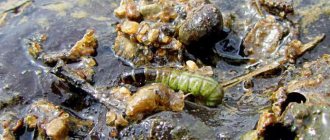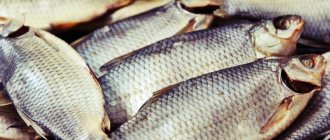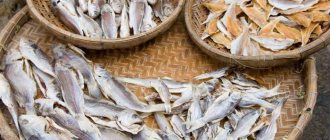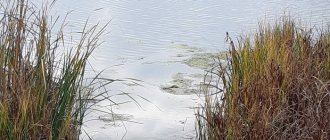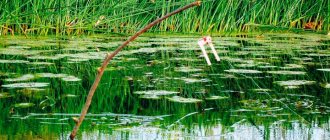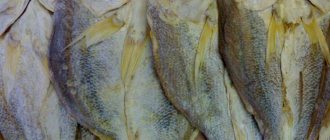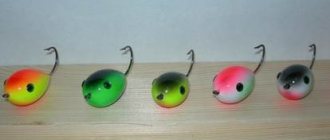Nowadays, homemade baits and baits are not very popular among fishermen, because specialized stores sell ready-made mixtures and baits. But if you want and have free time, it’s easy to come up with a good bait yourself, paying attention to stocks of non-perishable products.
Many people know that porridge is to the taste of various inhabitants of the underwater world, but not everyone uses pasta to catch peaceful fish.
Preparing mastyrka for fishing A classic recipe for fishing - mastyrka made from peas and semolina. It is more difficult to prepare than regular dough, but the results are worth the effort. In addition to bream, crucian carp, carp, silver bream, roach and other cyprinids take well to mastyrka.
Let's consider a recipe for a catchy bait made from pasta, which is liked by bream, large crucian carp, roach, silver bream and carp . So, what do you need for successful fishing with pasta?
What kind of pasta is used for fishing?
Content
When choosing pasta for fishing, you should choose high-quality products made from durum wheat. The shape of the pasta must suit the task at hand. Many fishermen consider dry star pasta with a diameter of up to a centimeter to be one of the most successful and versatile options. Indeed, star pasta for fishing is a very good option, but you shouldn’t stop there only, various shells, tubes and other forms work just as well.
There is no point in saving when choosing pasta - even the best varieties are not very expensive, store well, and are used little by little. At the same time, cheap pasta cannot be cooked correctly, which simply leads to spoilage of the product.
We will discuss how to cook pasta for fishing below, but now let’s look at its scope of application.
Only high-quality products are suitable for fishing
How to cook pasta for bream fishing
To prepare pasta, fishermen use different recipes and choose those that have proven more successful in practice. The easiest way to experiment with pasta is on small products, such as stars. Not only bream, but also other white fish, such as silver bream or roach, can bite on this type of pasta. The pasta bait has found wide use among fishermen. It is used in fishing with float tackle, attached to the hook of bottom devices, and in winter they do not forget about this attachment.
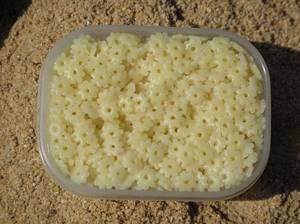
Stars take much less time to cook than other pasta products. They are prepared for fishing in much the same way as they are prepared for human consumption. After boiling a container of water, add a little salt to the liquid, then add the stars to the water and cook over low heat for several minutes until cooked. After which they are drained into a colander and washed from the fat under running cold tap water. The pasta turns out crumbly.
Another way to prepare stars is also simple. Place water in a saucepan and bring to a boil. Place a colander on top of the pan, into which the stars are poured. Since we don’t need a lot of pasta for fishing, in this version of cooking it is convenient to put small portions of stars in a colander. It turns out that the pasta is steamed. After the stars are ready, the colander is removed from the pan and its contents are washed under cold running water.
Read: Fishing with bark beetle larva
The finished pasta should be such that the pasta can be easily torn, but not easily crushed. For bottom fishing, hard pasta is usually used, while softer pasta is suitable for float fishing or winter fishing. When cooking for the first time, it is worth noting the time interval during which pasta of one or another hardness is cooked. Well, after that, cooking will be carried out with experience, timing the required time with a clock or stopwatch.
After cooking and washing the pasta, they are dried. To do this, pour the pasta onto an unfolded newspaper in a thin layer. After the newspaper has absorbed all the moisture, the nozzle becomes crumbly and separates well from each other. Then they are collected in a separate jar and go fishing for bream.
There are other ways to dry pasta, one of which is to dry the pasta on breadcrumbs. To do this, spread a thin layer of crackers onto a convenient plate or baking sheet, and place washed but still warm pasta on top. In such conditions, the nozzle perfectly transfers moisture to the crackers and dries quickly, and crumbs of crackers stick to the pasta, which creates an additional cloud of suspension and odor while fishing, getting into the water. This will attract fish to your bait to a greater extent. Another option for drying pasta is similar to the one described above, only instead of breadcrumbs, the well-known “Geyser” (or other) fine-grain bait is poured. This factory-made bait contains flavorings, which, together with the particles clinging to the pasta, will also additionally attract fish. Larger pasta takes much longer to cook than star pasta, but this is not as big of a problem. It is important that experimentally you can adapt to cooking any pasta, and for fishing it is best to take baits of different types and hardness.
Read: Breeding mealworms
Another option for preparing pasta is to fry it. For this, already cooked products are used, and they can even be slightly overcooked.
Fry them in a hot frying pan with the addition of oil. If the pasta initially turned out soft after cooking, then after frying it acquires more elastic properties, which has a positive effect on attaching it to the hook. Such pasta holds firmly on the hook. And the oil, absorbed into the pasta, gives it additional flavor and attractiveness to the fish. The main thing is not to overcook them, as the bream will bite less on an overcooked bait. Remove the finished pasta from the heat and roll in breadcrumbs. Good luck catching bream with pasta!
Subscribe to
our channel in Yandex Zen
Cooking methods and recipes
The question of how to properly cook pasta for fishing causes controversy among adherents of this attachment. Some insist on cooking until half-cooked or, in general, steaming in boiling water, others boil the pasta until ready and then air-dry it.
It is possible to use both the first and second options, then the bait prepared by the first method is more suitable for catching active fish using bottom gear, and the second one is more suitable for poor biting and fishing with a float rod. If you want to learn more about how to cook star pasta for fishing, then the method of cooking it is no different from other types of pasta.
Read more
Models and features of Yuzuri wobblers
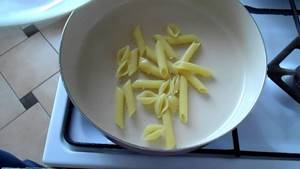
There are several ways to prepare pasta for fishing.
The following algorithm is common, suitable for all cooking methods:
- Pasta is dipped only in boiling salted water.
- The amount of water should be large - approximately 1 liter per 100 g of pasta.
- The cooking time is selected experimentally for each specific type of pasta and even for the manufacturer. The approximate time is 2 minutes for bottom fishing and 5 minutes for float fishing.
The cooked pasta is folded back and laid out in 1 layer on a waffle towel or other non-lint-absorbent fabric to dry. Dried pasta should not stick together, much less stick to your hands. Store pasta in the refrigerator in a closed container.
Instead of drying, pasta is often rolled in semolina, pea flour, and breadcrumbs. When fishing in cold water, fish and meat and bone meal are used for this purpose.
Flavors and flavoring additives are often added during the cooking process, but it is more advisable to do everything while fishing, because it will not be possible to change the smell, and preparing several servings is not always justified.

Fishing pasta is often sprinkled with breadcrumbs or pea flour
Recipes
There are many ways to cook pasta for fishing, and it’s not always possible to guess the recipe for an upcoming trip to a pond. The first time you will have to be guided by intuition, and a little later by experience.
Cooking in a colander
This cooking option is a close relative of the previous one, but it is even more “lazy”. Please note that in this way you need to cook a small portion of the bait at a time, otherwise sticking cannot be avoided. This method is optimal for “little things” such as “stars” and “rings”.
The cooking algorithm is similar to the previous one, with minor adjustments. In this case, the pasta is not poured into the pan freely, but with the direct participation of a colander. You should not indulge in idleness: a colander dipped in boiling water must be constantly shaken, made up and down movements - in a word, do your best to prevent sticking. It’s up to you to rinse or not, but you definitely need to dry it on a towel. An alternative option is to roll in breadcrumbs, pea flour or semolina: it will remove excess moisture and add a seductive taste and smell.
Steaming
Pour a handful of pasta into a mug or other container, fill it completely with boiling water, cover tightly with a lid and steam for about a minute (the time depends on the type and size of the product). Afterwards, the water is drained and the pasta is infused in a covered container. Solid varieties can be wrapped well in cloth so that the water cools more slowly, or placed in a warm place.
Then they are infused again for 10-15 minutes, but in an open or half-open container. This way the top pasta will dry out a little, become harder, and their color will darken. The pasta is dried and placed in a container with a lid: a container, a box, a jar and greased with sunflower oil.
Roasting
Many fishermen resort to frying cooked pasta in a large amount of oil. They are fried for 1-2 minutes over low heat. Then they are removed from the oil and placed in a container for the attachment. You can first roll it in breadcrumbs or semolina. You can also use fine ground bait, which already contains flavorings. It, like crackers, attracts fish not only with its smell, but also with the resulting turbidity.
Helpful information! Overcooked pasta can be dried in the oven or in the sun directly while fishing.
Angling tips
At the end of our publication, as always, there are bonus tips from experienced fishermen:
- If possible, prepare fresh bait. Ready-made pasta can be stored in the refrigerator for several days, but it’s better not to be lazy and prepare a fresh pasta before each trip.
- When time is short, use household appliances. It is better to dry pasta (especially if it is not al dente) in the microwave or oven (on convection mode). Or you can take the time to fry them in a frying pan (the use of unrefined sunflower oil and breading in breadcrumbs is encouraged).
- Don't forget about the existence of specialized stores. If you don’t have time for the word “absolutely”, take a look at a fishing store. Surely on the counter there will be attractive portioned jars of pasta with various attractants.
- In cold water, use attractants with animal scents. In autumn and spring, fish gravitate towards animal food, therefore both “sandwiches” with maggot, bloodworms and worms, as well as flavors such as “worm”, “maggot”, “mussel”, “shrimp” and so on work well.
Use of flavorings
Flavors for fishing are of great importance, because the right scent can radically change the result of fishing.
Pasta, while attractive to fish, does not have its own outstanding aroma, so the use of various attractants can increase their effectiveness.
Sources of odor can be:
- natural plants (garlic, dill);
- kitchen herbs and spices (vanilla, cinnamon, cardamom, fennel, etc.);
- cocoa and chocolate;
- pharmaceutical preparations (Corvalol, valerian);
- essential oils.
It is allowed to use flavors produced specifically for fishing - various dips and sprays. Their use significantly expands the range of available odors: mussel, shrimp, bloodworm, etc. And the main advantage is that it is convenient to experiment with them while fishing.
The main rule in using fragrances is caution: an insufficiently strong smell is much better than an excessive one. By overdoing it, it is very easy to scare the fish away from the bait.

Flavorings are often added during the cooking process of pasta.
Speaking about flavorings, it is worth touching on the issue of using flavoring additives and dyes. Often fish respond better to baits of a certain color, the leaders among which are red, yellow and green. Various food colors are suitable for coloring.
As flavoring additives, you should try ascorbic and citric acid, salt, sugar, honey. The dosage should be treated with the same care as in the case of odors.
All this opens up a huge field for experimentation and allows you to create bait options for different fishing conditions.
Read more
Catching chub with wobblers
Aromatization
Aromatizing bait to attract fish has long been a well-known technique. Here the choice is limited only by your imagination and financial capabilities. Here are the most common options.
- Oils. It can be absolutely any oil - refined and unrefined sunflower, corn, flaxseed, olive and even butter.
- Bulk flavorings. Ground peanuts, sesame seeds, fennel, coffee beans, cocoa powder, crushed pumpkin and sunflower seeds have proven themselves well.
- Essential oils. There is a lot of room for imagination here. We list the most popular types of oils: eucalyptus;
- jasmine;
- bergamot;
- anise;
- sandalwood;
- garlic;
- nutmeg.
It happens that fish respond better to a colored bait, while completely ignoring the usual white one. In this case, some fishermen resort to the help of carbonated colored drinks, for example, tarragon, or roll ready-made pasta in store-bought jelly with the flavors of various berries. You can also use cinnamon, which will color the nozzle brownish and give a characteristic sweet smell.
Flavorings can be added both during cooking and after cooking.
Adding oil will not only add additional flavor, but will also help prevent the pasta from sticking together, which will make the drying process easier in the future.
Separately, it should be noted that if you add a little lemon juice or citric acid while cooking pasta, the resulting bait will increase your chances of catching carp.
Important! Handle fragrances carefully. Too strong and pungent odors, instead of luring the fish, can scare them all away.
Nozzle methods
Properly prepared pasta holds the hook perfectly, allowing you to make several casts without changing the bait. They are planted one at a time or several pieces, depending on the size of the fish that is supposed to be caught. It is also possible to use hair rigs, and not only carp, but also cupid, large crucian carp and bream are caught this way.
Pasta also works well as a component of a “sandwich”, for example, in combination with maggots, worms, or corn. It is also possible to give a fishing pasta bait positive buoyancy by adding a foam ball to the hook, making the bait more visible to the fish.
When attaching pasta, you must ensure that, regardless of the method of insertion, the tip of the hook is always open. Failure to follow this rule will result in the fish not being caught in most cases.
Originally posted 2018-08-03 11:36:57.
How to properly hook
The technology for equipping a hook with pasta bait is quite simple and practically no different from the traditional one used for other types of bait. At the same time, you still need to place the pasta on the hook more carefully and gradually, observing all the principles of safe use of fishing gear.
Find out also how to catch bream in September on a feeder.
It is easiest to put on large items; just place them on the tip, and then carefully thread them through the bend and to the end of the fore-end. If the pasta is excessively long, it is broken several times, after which each turn is threaded one after the other.
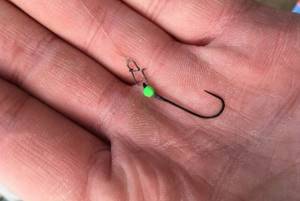
The stars are planted a little differently; often at least 5 pieces are used for this. To do this, each unit is threaded through a through hole (in the center), after which it is passed through the bend and to the edge of the forend. They do this until the hook is completely hidden under the bait.
